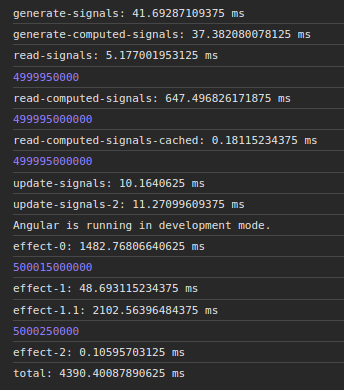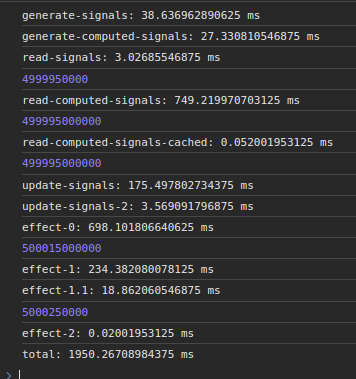vs Angular
SYSTEM CONFIGURATION:
- CPU: Intel(R) Core(TM) i7-8750H CPU @ 2.20GHz (6 cores / 12 threads)
- Memory: 32Go
- OS: Ubuntu 20.04 LTS
- Browser: Chrome 121
- Date: 2024-02-20
- @lirx/core: 1.6.0
- angular: 17.2.1
First, we think it's important to notice that @lirx/core has a different implementation of Signals that Angular.
This is not a fork, nor a rework, but rather a separate implementation.
They share some concepts and optimization, but we have a different approach on the Signals' updates.
When benchmarking, we may say that the Angular's Signals are really well optimized, and achieving similar or better results was a real challenge, so we may felicitate their teams for such an amazing work.
But enough congratulations, and let's jump into the benchmarks, exposing the difference between the two.
Benchmark
Expand the code
function run(): void {
console.time('total');
console.time('generate-signals');
const signals = Array.from({ length: 1e5 }, (_, index: number) => signal(index));
console.timeEnd('generate-signals');
console.time('generate-computed-signals');
const computedSignals = Array.from({ length: 1e5 }, () => computed((): number => {
return signals.reduce((sum: number, signal: IReadonlySignal<number>) => {
return sum + signal();
}, 0);
}));
console.timeEnd('generate-computed-signals');
computedSignals.splice(1e2, Number.POSITIVE_INFINITY);
let value: number = 0;
console.time('read-signals');
value = signals.reduce((sum: number, signal: IReadonlySignal<number>) => {
return sum + signal();
}, 0);
console.timeEnd('read-signals');
console.log(value);
console.time('read-computed-signals');
value = computedSignals.reduce((sum: number, signal: IReadonlySignal<number>) => {
return sum + signal();
}, 0);
console.timeEnd('read-computed-signals');
console.log(value);
console.time('read-computed-signals-cached');
value = computedSignals.reduce((sum: number, signal: IReadonlySignal<number>) => {
return sum + signal();
}, 0);
console.timeEnd('read-computed-signals-cached');
console.log(value);
console.time('update-signals');
signals.forEach((signal: ISignal<number>): void => {
signal.set(signal() + 1);
});
console.timeEnd('update-signals');
console.time('update-signals-2');
signals.forEach((signal: ISignal<number>): void => {
signal.set(signal() + 1);
});
console.timeEnd('update-signals-2');
let cmd: number = 0;
console.time('effect-0');
effect(() => {
if (cmd === 0) {
cmd++;
value = computedSignals.reduce((sum: number, signal: IReadonlySignal<number>) => {
return sum + signal();
}, 0);
console.timeEnd('effect-0');
console.log(value);
queueMicrotask(() => {
console.time('effect-1');
signals.forEach((signal: ISignal<number>): void => {
signal.set(signal() + 1);
});
});
} else if (cmd === 1) {
cmd++;
console.timeEnd('effect-1');
console.time('effect-1.1');
value = signals.reduce((sum: number, signal: IReadonlySignal<number>) => {
return sum + signal();
}, 0);
console.timeEnd('effect-1.1');
console.log(value);
queueMicrotask(() => {
console.time('effect-2');
signals[0].set(0);
});
} else if (cmd === 2) {
cmd++;
console.timeEnd('effect-2');
console.timeEnd('total');
}
});
}
run();
Results
Angular

@lirx/core

Comments
When creating signals (generate-signals), both frameworks are extremely efficient, and generating millions of them is not a problem.
The same is true for computed (generate-computed-signals), where no significant differences may be observed.
Reading signals is extremely fast too (read-signals, read-computed-signals), both caching the values (read-computed-signals-cached),
avoiding unnecessary recomputation, and having similar performances.
Differences happens when we update signals (update-signals):
Angular is far faster (10ms vs 175ms) as it simply marks the signal as outdated without notifying its observers.
In the contrary, @lirx/core chose to immediately notify the observers, costing more to mark all observers as outdated too.
However, consecutive signal writes (update-signals-2) have similar performances, with a small advantage for @lirx/core.
The choice to notify immediately the observers, was done to increase the performances when Signals are observed through effect.
And we may immediately see the difference: the first effect (effect-0) takes ~1500ms with angular versus ~700ms with @lirx/core.
A gain of 800ms ! For applications using a lot of effect, this is a huge boost.
We consider that in practice, we will use far more effect to be able to observe signal changes (to update the DOM for example),
that we'll mutate their value in an unobserved context.
effect-1 updates the values of all the signals, and we may see that Angular remains the champion (48ms vs 234ms)
as we have the same behaviour as update-signals. But the gap is reduced.
However, with effect-1.1 (when the effect is called again due to the previous changes),
we may see the absolute boost of immediately notifying the observers:
2100ms for Angular versus 20ms with @lirx/core. It's just crunching the stats.
If we cumulate both writing (faster on Angular) and observing (faster on @lirx/core), we get: 48 + 2102 = 2150ms vs 234 + 18 = 252ms.
So @lirx/core outperforms Angular by a factor of 8 (if we consider that observing the values is more important that updating them).
But fundamentally, this is the purpose of Signals: being observable and react to their changes.
So we think our choice is the right one.
Finally, if we focus on the resulting size, both packages are efficient: minziped Angular's signals are around ~2kB and @lirx/core ~1.3kB.
However, @lirx/core has the advantage to be embeddable without all the Angular's framework (which adds a minimum of ~23kB minziped, resulting in a minimal application of ~25kB).